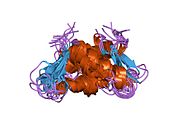HIST1H1B
| H1-5 | |||||||||||||||||||||||||||||||||||||||||||||||||||
|---|---|---|---|---|---|---|---|---|---|---|---|---|---|---|---|---|---|---|---|---|---|---|---|---|---|---|---|---|---|---|---|---|---|---|---|---|---|---|---|---|---|---|---|---|---|---|---|---|---|---|---|
 | |||||||||||||||||||||||||||||||||||||||||||||||||||
| |||||||||||||||||||||||||||||||||||||||||||||||||||
| Identifiers | |||||||||||||||||||||||||||||||||||||||||||||||||||
| Aliases | H1-5, H1, H1.5, H1B, H1F5, H1s-3, histone cluster 1, H1b, histone cluster 1 H1 family member b, HIST1H1B, H1.5 linker histone, cluster member | ||||||||||||||||||||||||||||||||||||||||||||||||||
| External IDs | OMIM: 142711; MGI: 1861461; HomoloGene: 136789; GeneCards: H1-5; OMA:H1-5 - orthologs | ||||||||||||||||||||||||||||||||||||||||||||||||||
| |||||||||||||||||||||||||||||||||||||||||||||||||||
| |||||||||||||||||||||||||||||||||||||||||||||||||||
| |||||||||||||||||||||||||||||||||||||||||||||||||||
| |||||||||||||||||||||||||||||||||||||||||||||||||||
| |||||||||||||||||||||||||||||||||||||||||||||||||||
| Wikidata | |||||||||||||||||||||||||||||||||||||||||||||||||||
| |||||||||||||||||||||||||||||||||||||||||||||||||||
Histone H1.5 is a protein that in humans is encoded by the HIST1H1B gene.[5][6][7][8]
Histones are basic nuclear proteins responsible for nucleosome structure of the chromosomal fiber in eukaryotes. Two molecules of each of the four core histones (H2A, H2B, H3, and H4) form an octamer, around which approximately 146 bp of DNA is wrapped in repeating units, called nucleosomes. The linker histone, H1, interacts with linker DNA between nucleosomes and functions in the compaction of chromatin into higher order structures. This gene is intronless and encodes a member of the histone H1 family. Transcripts from this gene lack polyA tails but instead contain a palindromic termination element. This gene is found in the small histone gene cluster on chromosome 6p22-p21.3.[8]
References
- ^ a b c GRCh38: Ensembl release 89: ENSG00000184357 – Ensembl, May 2017
- ^ a b c GRCm38: Ensembl release 89: ENSMUSG00000058773 – Ensembl, May 2017
- ^ "Human PubMed Reference:". National Center for Biotechnology Information, U.S. National Library of Medicine.
- ^ "Mouse PubMed Reference:". National Center for Biotechnology Information, U.S. National Library of Medicine.
- ^ Albig W, Meergans T, Doenecke D (Mar 1997). "Characterization of the H1.5 gene completes the set of human H1 subtype genes". Gene. 184 (2): 141–8. doi:10.1016/S0378-1119(96)00582-3. PMID 9031620.
- ^ Albig W, Kioschis P, Poustka A, Meergans K, Doenecke D (Apr 1997). "Human histone gene organization: nonregular arrangement within a large cluster". Genomics. 40 (2): 314–22. doi:10.1006/geno.1996.4592. PMID 9119399.
- ^ Marzluff WF, Gongidi P, Woods KR, Jin J, Maltais LJ (Oct 2002). "The human and mouse replication-dependent histone genes". Genomics. 80 (5): 487–98. doi:10.1016/S0888-7543(02)96850-3. PMID 12408966.
- ^ a b "Entrez Gene: HIST1H1B histone cluster 1, H1b".
Further reading
- Ohe Y, Hayashi H, Iwai K (1990). "Human spleen histone H1. Isolation and amino acid sequences of three minor variants, H1a, H1c, and H1d". J. Biochem. 106 (5): 844–57. doi:10.1093/oxfordjournals.jbchem.a122941. PMID 2613692.
- van Wijnen AJ, Wright KL, Massung RF, et al. (1988). "Two target sites for protein binding in the promoter region of a cell cycle regulated human H1 histone gene". Nucleic Acids Res. 16 (2): 571–92. doi:10.1093/nar/16.2.571. PMC 334679. PMID 2829131.
- Collar DG, Wright KL, van Wijnen AJ, et al. (1988). "The human H1 histone gene FNC16 is functionally expressed in proliferating HeLa S3 cells and is down-regulated during terminal differentiation in HL60 cells". J. Biol. Chem. 263 (31): 15860–3. doi:10.1016/S0021-9258(18)37527-6. PMID 3182772.
- Ohe Y, Hayashi H, Iwai K (1986). "Human spleen histone H1. Isolation and amino acid sequence of a main variant, H1b". J. Biochem. 100 (2): 359–68. doi:10.1093/oxfordjournals.jbchem.a121722. PMID 3782055.
- Carozzi N, Marashi F, Plumb M, et al. (1984). "Clustering of human H1 and core histone genes". Science. 224 (4653): 1115–7. Bibcode:1984Sci...224.1115C. doi:10.1126/science.6719136. PMID 6719136.
- Aprelikova O, Xiong Y, Liu ET (1995). "Both p16 and p21 families of cyclin-dependent kinase (CDK) inhibitors block the phosphorylation of cyclin-dependent kinases by the CDK-activating kinase". J. Biol. Chem. 270 (31): 18195–7. doi:10.1074/jbc.270.31.18195. PMID 7629134.
- Albig W, Drabent B, Kunz J, et al. (1993). "All known human H1 histone genes except the H1(0) gene are clustered on chromosome 6". Genomics. 16 (3): 649–54. doi:10.1006/geno.1993.1243. PMID 8325638.
- Albig W, Doenecke D (1998). "The human histone gene cluster at the D6S105 locus". Hum. Genet. 101 (3): 284–94. doi:10.1007/s004390050630. PMID 9439656. S2CID 38539096.
- New L, Zhao M, Li Y, et al. (1999). "Cloning and characterization of RLPK, a novel RSK-related protein kinase". J. Biol. Chem. 274 (2): 1026–32. doi:10.1074/jbc.274.2.1026. PMID 9873047.
- Chadwick BP, Willard HF (2001). "A Novel Chromatin Protein, Distantly Related to Histone H2a, Is Largely Excluded from the Inactive X Chromosome". J. Cell Biol. 152 (2): 375–84. doi:10.1083/jcb.152.2.375. PMC 2199617. PMID 11266453.
- Strausberg RL, Feingold EA, Grouse LH, et al. (2003). "Generation and initial analysis of more than 15,000 full-length human and mouse cDNA sequences". Proc. Natl. Acad. Sci. U.S.A. 99 (26): 16899–903. Bibcode:2002PNAS...9916899M. doi:10.1073/pnas.242603899. PMC 139241. PMID 12477932.
- Giampuzzi M, Oleggini R, Di Donato A (2003). "Demonstration of in vitro interaction between tumor suppressor lysyl oxidase and histones H1 and H2: definition of the regions involved". Biochim. Biophys. Acta. 1647 (1–2): 245–51. doi:10.1016/s1570-9639(03)00059-1. PMID 12686141.
- Mungall AJ, Palmer SA, Sims SK, et al. (2003). "The DNA sequence and analysis of human chromosome 6". Nature. 425 (6960): 805–11. Bibcode:2003Natur.425..805M. doi:10.1038/nature02055. PMID 14574404.
- Vaquero A, Scher M, Lee D, et al. (2004). "Human SirT1 interacts with histone H1 and promotes formation of facultative heterochromatin". Mol. Cell. 16 (1): 93–105. doi:10.1016/j.molcel.2004.08.031. PMID 15469825.
- Gerhard DS, Wagner L, Feingold EA, et al. (2004). "The Status, Quality, and Expansion of the NIH Full-Length cDNA Project: The Mammalian Gene Collection (MGC)". Genome Res. 14 (10B): 2121–7. doi:10.1101/gr.2596504. PMC 528928. PMID 15489334.
- Garcia BA, Busby SA, Barber CM, et al. (2005). "Characterization of phosphorylation sites on histone H1 isoforms by tandem mass spectrometry". J. Proteome Res. 3 (6): 1219–27. doi:10.1021/pr0498887. PMID 15595731.
- Andersen JS, Lam YW, Leung AK, et al. (2005). "Nucleolar proteome dynamics". Nature. 433 (7021): 77–83. Bibcode:2005Natur.433...77A. doi:10.1038/nature03207. PMID 15635413. S2CID 4344740.
- v
- t
- e
-
 1ghc: HOMO-AND HETERONUCLEAR TWO-DIMENSIONAL NMR STUDIES OF THE GLOBULAR DOMAIN OF HISTONE H1: FULL ASSIGNMENT, TERTIARY STRUCTURE, AND COMPARISON WITH THE GLOBULAR DOMAIN OF HISTONE H5
1ghc: HOMO-AND HETERONUCLEAR TWO-DIMENSIONAL NMR STUDIES OF THE GLOBULAR DOMAIN OF HISTONE H1: FULL ASSIGNMENT, TERTIARY STRUCTURE, AND COMPARISON WITH THE GLOBULAR DOMAIN OF HISTONE H5
 | This article on a gene on human chromosome 6 is a stub. You can help Wikipedia by expanding it. |
- v
- t
- e


















